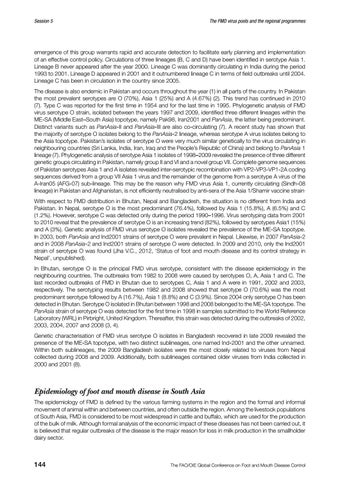Session 5
The FMD virus pools and the regional programmes
emergence of this group warrants rapid and accurate detection to facilitate early planning and implementation of an effective control policy. Circulations of three lineages (B, C and D) have been identified in serotype Asia 1. Lineage B never appeared after the year 2000. Lineage C was dominantly circulating in India during the period 1993 to 2001. Lineage D appeared in 2001 and it outnumbered lineage C in terms of field outbreaks until 2004. Lineage C has been in circulation in the country since 2005. The disease is also endemic in Pakistan and occurs throughout the year (1) in all parts of the country. In Pakistan the most prevalent serotypes are O (70%), Asia 1 (25%) and A (4.67%) (2). This trend has continued in 2010 (7). Type C was reported for the first time in 1954 and for the last time in 1995. Phylogenetic analysis of FMD virus serotype O strain, isolated between the years 1997 and 2009, identified three different lineages within the ME-SA (Middle East–South Asia) topotype, namely Pak98, Iran2001 and PanAsia, the latter being predominant. Distinct variants such as PanAsia-II and PanAsia-III are also co-circulating (7). A recent study has shown that the majority of serotype O isolates belong to the PanAsia-2 lineage, whereas serotype A virus isolates belong to the Asia topotype. Pakistan’s isolates of serotype O were very much similar genetically to the virus circulating in neighbouring countries (Sri Lanka, India, Iran, Iraq and the People’s Republic of China) and belong to PanAsia 1 lineage (7). Phylogenetic analysis of serotype Asia 1 isolates of 1998–2009 revealed the presence of three different genetic groups circulating in Pakistan, namely group II and VI and a novel group VII. Complete genome sequences of Pakistan serotypes Asia 1 and A isolates revealed inter-serotypic recombination with VP2-VP3-VP1-2A coding sequences derived from a group VII Asia 1 virus and the remainder of the genome from a serotype A virus of the A-Iran05 (AFG-07) sub-lineage. This may be the reason why FMD virus Asia 1, currently circulating (Sindh-08 lineage) in Pakistan and Afghanistan, is not efficiently neutralised by anti-sera of the Asia 1/Shamir vaccine strain. With respect to FMD distribution in Bhutan, Nepal and Bangladesh, the situation is no different from India and Pakistan. In Nepal, serotype O is the most predominant (76.4%), followed by Asia 1 (15.8%), A (6.5%) and C (1.2%). However, serotype C was detected only during the period 1990–1996. Virus serotyping data from 2001 to 2010 reveal that the prevalence of serotype O is an increasing trend (82%), followed by serotypes Asia1 (15%) and A (3%). Genetic analysis of FMD virus serotype O isolates revealed the prevalence of the ME-SA topotype. In 2003, both PanAsia and Ind2001 strains of serotype O were prevalent in Nepal. Likewise, in 2007 PanAsia-2 and in 2008 PanAsia-2 and Ind2001 strains of serotype O were detected. In 2009 and 2010, only the Ind2001 strain of serotype O was found (Jha V.C., 2012, ‘Status of foot and mouth disease and its control strategy in Nepal’, unpublished). In Bhutan, serotype O is the principal FMD virus serotype, consistent with the disease epidemiology in the neighbouring countries. The outbreaks from 1982 to 2008 were caused by serotypes O, A, Asia 1 and C. The last recorded outbreaks of FMD in Bhutan due to serotypes C, Asia 1 and A were in 1991, 2002 and 2003, respectively. The serotyping results between 1982 and 2008 showed that serotype O (70.6%) was the most predominant serotype followed by A (16.7%), Asia 1 (8.8%) and C (3.9%). Since 2004 only serotype O has been detected in Bhutan. Serotype O isolated in Bhutan between 1998 and 2008 belonged to the ME-SA topotype. The PanAsia strain of serotype O was detected for the first time in 1998 in samples submitted to the World Reference Laboratory (WRL) in Pirbright, United Kingdom. Thereafter, this strain was detected during the outbreaks of 2002, 2003, 2004, 2007 and 2008 (3, 4). Genetic characterisation of FMD virus serotype O isolates in Bangladesh recovered in late 2009 revealed the presence of the ME-SA topotype, with two distinct sublineages, one named Ind-2001 and the other unnamed. Within both sublineages, the 2009 Bangladesh isolates were the most closely related to viruses from Nepal collected during 2008 and 2009. Additionally, both sublineages contained older viruses from India collected in 2000 and 2001 (8).
Epidemiology of foot and mouth disease in South Asia The epidemiology of FMD is defined by the various farming systems in the region and the formal and informal movement of animal within and between countries, and often outside the region. Among the livestock populations of South Asia, FMD is considered to be most widespread in cattle and buffalo, which are used for the production of the bulk of milk. Although formal analysis of the economic impact of these diseases has not been carried out, it is believed that regular outbreaks of the disease is the major reason for loss in milk production in the smallholder dairy sector.
144
The FAO/OIE Global Conference on Foot and Mouth Disease Control
















